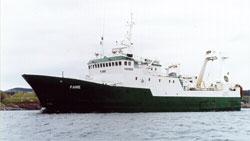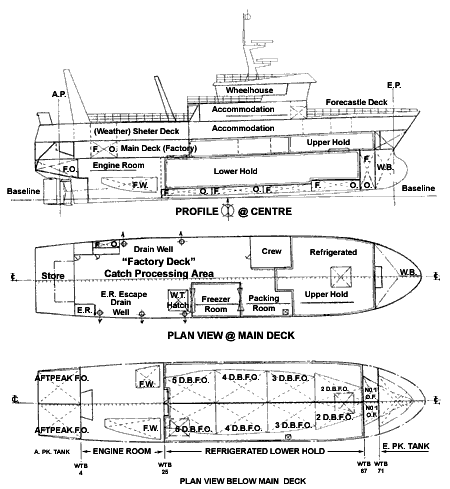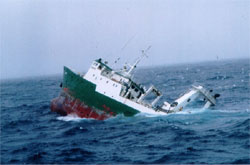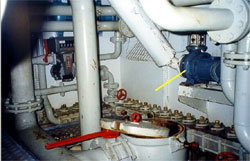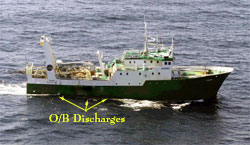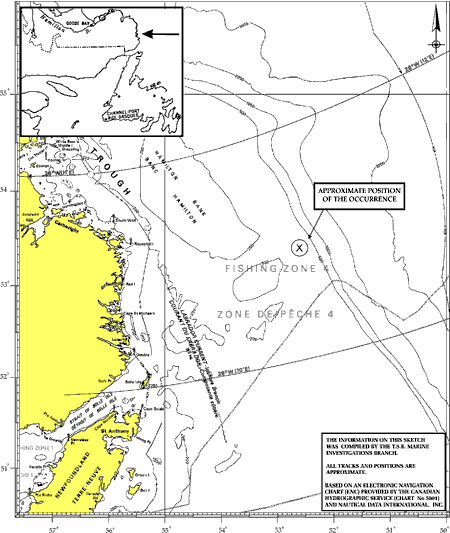Flooding and sinking
Shrimp factory freezer trawler Fame
120 nautical miles Northeast of
Belle Isle, Newfoundland and Labrador
The Transportation Safety Board of Canada (TSB) investigated this occurrence for the purpose of advancing transportation safety. It is not the function of the Board to assign fault or determine civil or criminal liability. This report is not created for use in the context of legal, disciplinary or other proceedings. See Ownership and use of content. Masculine pronouns and position titles may be used to signify all genders to comply with the Canadian Transportation Accident Investigation and Safety Board Act (S.C. 1989, c. 3).
Summary
At about 1500 on 18 April 2001, the factory freezer trawler Fame suffered a major failure in the factory freezer equipment that resulted in the release of the entire charge of refrigerant into the engine room. The refrigerant quickly displaced the oxygen in the engine room, which caused the total loss of main and auxiliary power. With a 3° to 4° starboard list, the vessel remained without electrical power until the early hours of the next morning. As the winds and seas increased, the list became 8° to 10°. Inspection of the fish processing tween-deck showed an accumulation of seawater on the starboard side and the starboard list increased to 28° to 30°. The decision was made to abandon ship. On 19 April at about 0845, 21 crewmembers abandoned the vessel into two liferafts, while the remaining three crewmembers were taken off the vessel by the fast rescue craft from a nearby fishing vessel. The Fame subsequently downflooded and sank stern first.
Factual information
| Name | "FAME (ex Montreal Viking, ex Nordbugvin)" |
|---|---|
| Port of Registry | Halifax |
| Flag | Canada |
| Registry/Licence Number | 806621 |
| Type | Shrimp Factory Freezer Trawler |
| Gross Tonnage | 1025 t |
| Length | 46.5 m |
| Draught | 4.8 m |
| Built | Langsten Slip & Batbyggeri A/S, 1977 |
| Propulsion | Wichmann 8V28B, 1343 kW |
| Number of Crew | 24 |
| Registered Owner | Fame Fisheries Limited, St. John's, Newfoundland and Labrador |
Description of the vessel
The vessel was built in Norway in 1977 as a single-screw stern trawler of all-welded steel construction, equipped for onboard fish processing and freezer storage. The hull was subdivided by four transverse watertight bulkheads, three of which extended from the keel up to main deck level, while the fourth extended up to the shelter deck as a collision bulkhead. A watertight inner bottom, enclosing double-bottom tanks extended for the length of the fish hold, while the hull in way of the main engine room was of single-bottom construction.
At various times since the vessel came under Canadian ownership in 1986, additions and changes to the outfit and layout of the catch-processing equipment were carried out. At the time of the occurrence, she was equipped for onboard processing and freezer storage of shrimp catches. The shrimp was processed at the after end of main deck (generally referred to as the "factory deck") in the tween-deck space below the weather deck. The shrimp-processing machinery space extended forward of midships on the starboard side.
The location of the engine room, decks, watertight hatches, oil fuel, water ballast, and freshwater tanks, refrigerated upper and lower holds, shrimp-processing areas, and crew accommodation, etc. were as shown in the Outline General Arrangement (see Figure 1).
History of the voyage
The Fame, with a crew of 24, departed Argentia, Newfoundland and Labrador, on 13 April 2001 en route to the fishing grounds in the Labrador Sea, approximately 117 nautical miles northeast of Belle Isle, Newfoundland and Labrador (see Appendix A). The vessel arrived at its destination and commenced fishing for shrimp. At 1500Footnote 1 on 18 April 2001, a loud bang was heard which was followed by an abrupt shutdown of the main engine and an electrical blackout of the vessel.
The engineer on watch was on the factory deck at the time of the power failure and electrical blackout and immediately went to the engine room to investigate the cause. Upon entering the engine room, he encountered a thick, fog-like atmosphere and almost immediately became dizzy and disoriented. He left the engine room, returned to the factory deck and collapsed on deck for a short period. He collapsed twice more as he made his way to the chief engineer's cabin.
The chief engineer went to the engine room and he too encountered the heavy, fog-like atmosphere. He decided to enter the engine room without a self-contained breathing apparatus (SCBA), but had only descended 3 - 4 steps when he was forced out by the smell of the vapour. He was soon met by the other watchkeeping engineer, who only stuck his head through the opened engine room door before being forced to withdraw.
It was at first assumed that there had been an engine room fire and that the halon smothering gas had self-released and extinguished the fire. About an hour later, it was decided to enter the engine room, using SCBA, and an engineer entered the space alone to take a quick look. During his brief trip into the upper engine room, he saw no sign of fire or heat. He did, however, report feeling very cold and that his skin felt like it was burning.
A short time later, two engineers wearing SCBA entered the engine room and conducted a more extensive inspection of the upper landing area. When they exited the space, they reported that there was no indication of fire but that they felt very cold and that their skin had a burning sensation. After this visit, the two engineers returned to the engine room to check out the lower levels where they discovered that, while there was no sign of fire, the standby (starboard) liquid refrigerant pump was totally destroyed. As a precautionary measure, they closed all the sea suction valves when in the engine room.
The master, now aware that the fog-like atmosphere in the engine room was refrigerant gas and that it would not dissipate quickly, started to negotiate a tow from one of the other vessels fishing in the immediate area.
As wind and sea conditions were favourable and the vessel had only a slight starboard list (which was reportedly normal for this vessel), there was no sense of urgency and the decision was made to wait until a tow was available. Throughout the evening and night, the two engineers made hourly trips into the engine room to check the bilges for water, but none was detected. On one of these visits, an unsuccessful attempt was made to start one of the auxiliary generators. The factory deck was also monitored by the crew. During this period, no additional water other than that on the factory deck at the time of the blackout was noticed.
At approximately 0400 on 19 April 2001, the wind started to pick up and, by 0500, had reached an estimated 25 to 30 knots and the sea height had increased to two metres. At 0500, the vessel's starboard list, which had remained at a steady 3° to 4°, quickly increased to 8° to 10°. Given the windage of the vessel and the sea conditions, this was not considered unusual, but another visit was made to check the engine room bilges. No water was detected there but some was noticed on the starboard side of the factory deck.
Between 0500 and 0630, the list increased to an estimated 18° to 20°. At 0534, the vessel issued a urgency message, indicating that it had no power, was drifting with a starboard list and had no pumps to discharge the water from the tween-deck space. At 0730, a fishing vessel in the area was requested to take the vessel in tow. As the tow was being connected, two of the engineers went to the engine room to once again check the bilges for water. Finding none, another attempt was made to start an auxiliary generator on an upper level of the engine room. This time, the generator started and electrical power was restored.
On leaving the engine room, and with the factory deck now illuminated, the engineers entered the fish processing area and noticed water on the starboard side of the factory deck, which was estimated to be 1.7 metres deep. An attempt was made to pump the water out using three starboard side wastewater discharge pumps, but because their starter boxes were under water, this was not possible. A further attempt was made to de-water the factory deck using a spare electric submersible pump, but this effort also failed.
At approximately 0800, the vessel again lost electrical power and blacked out. The SCBA air supply was also close to running out, and the engineers left the factory deck for the final time, leaving the engine room door open. With the vessel now under tow, the list increased to 28° to 30° and at approximately the same time a rescue aircraft arrived and dropped four portable salvage pumps. As the air drop was being carried out, the situation was considered critical and the decision was made to abandon ship.
At 0845, 21 crewmembers wearing immersion suits abandoned ship into two liferafts and were picked up by a nearby fishing vessel. The three remaining crewmembers abandoned ship into a fast rescue craft (FRC) from another fishing vessel in the area. At 1250, on 20 April 2001, the Fame heeled to starboard, downflooded and sank stern first in position 53°05′ N, 52°36′ W.
Injuries to persons
No one was injured.
Damage to vessel
Prior to the loss of propulsion and electrical power, no structural damage or failure affecting the watertight integrity of the vessel was observed. The vessel sank and was subsequently declared a total loss.
Damage to environment
When the vessel sank, there was approximately 155 000 litres of marine diesel oil onboard. The damage to the environment was considered minimal.
Vessel certification
The vessel held the class +1A1 Stern Trawler KMC ICE-1C with Det Norske Veritas at the time of the occurrence. It was also subject to regular inspection under the Transport Canada Marine Safety (TCMS) Large Fishing Vessel Inspection Regulations (LFVIR).
The Fame was certificated and equipped in accordance with the regulations. The vessel was last issued a Safety Inspection Certificate (SIC 31) on 26 October 2000.
Personnel certification
The master and officers of the vessel were in possession of valid certificates for their positions and the trade in which they were engaged.
Personnel history
The master had 29 years experience at sea and approximately 4 years as commanding officer. He had previously sailed on the vessel in various capacities before joining it as master in February 2000.
Weather information
The weather conditions at the time of the occurrence were described as light airs with calm seas. At the time of the sinking the weather had deteriorated to winds from the southwest at 25 to 30 knots with an estimated sea height of two metres.
Stability requirements
As a stern trawler exceeding 24.4 metres in registered length and over 150 gross registered tonnes (GRT), the Fame was required to comply with the requirements of the LFVIR, including those related to intact stability.
Following a major re-fit, the vessel was the subject of an inclining experiment on 09 May 1994, the results of which were accepted by the (then) Ship Safety Branch of Transport Canada (SSB) and stamped "Approved" on 22 August 1994. The related Trim and Stability Booklet was also accepted by SSB and stamped "Approved" on 19 January 1995.
Stability approval for large fishing vessels is based on the submitted data meeting or exceeding minimum criteria detailed in STAB 4 of the TCMS publication, Stability, Subdivision and Load Line Standards (TP 7301). Compliance with the minimum criteria of STAB 4 ensures that vessels attain what are generally recognised as adequate intact transverse stability characteristics throughout a range of standard loading conditions related to the vessel's intended service.
STAB 4 primarily addresses intact transverse stability, which is dependent on the watertight integrity of the hull being maintained, together with the proper closure of openings on or below the weather deck, such as doors, hatches, ventilators, air pipes, overboard discharges, and fish waste/offal chutes, etc.
The criteria also ensure adequate margins of reserve buoyancy to withstand and recover from the dynamic effects of severe weather and other detrimental external influences which may be met in normal operation.
Current Canadian standards do not address large fishing vessel stability in a damaged or partially flooded condition, nor do the large fishing vessel hull construction requirements call for transverse watertight subdivision to specifically ensure the survival of the vessel in the event of flooding in a fish hold or any other single large compartment below the bulkhead deck.
Vessel loading, trim & stability
The approved Trim and Stability Booklet contained certain restrictions regarding the distribution of oil fuel in the various tanks and the sequence in which fuel was to be consumed. The restrictions also stated that "AFTER PEAK OIL FUEL TANKS ARE NOT TO BE USED ".
The "General Notes to the Master" section of the booklet repeated the oil fuel distribution and consumption sequence and also stated that "In addition, it is required that the vessel upon departure from port shall NOT carry fuel in the aft peak tanks ".
The port departure loading condition and all other typical operating conditions included in the approved stability booklet were compiled with the aft peak tanks empty. Aft peak tanks fuel oil capacity and free-surface effects characteristics were also included in the booklet. However, no loading conditions were provided for the guidance of the master addressing the detrimental free surface effects on the transverse stability of the vessel in the event of oil fuel being transferred to the aft peak tanks while at sea.
The oil fuel tanks, fresh and ballast water tanks sounding records were lost when the vessel sank. Consequently, details of the distribution and quantities of consumable liquids, together with preservation salt and shrimp catch onboard at the time of the sinking, are not available. Subsequent to the sinking, oil fuel and freshwater tanks contents and the cargo deadweight distribution were estimated by the master and chief engineer.
The estimated loading data shows the shrimp catch and preservation salt were stowed symmetrically to port and starboard. A summation of the oil fuel and freshwater tanks contents indicates an excess of some 26 tonnes to port. This imbalance conflicts with the steady heel of approximately 3° to starboard reportedly maintained by the vessel in calm weather prior to and after the initial loss of electrical power.
The reported oil fuel distribution indicates the port and starboard aft peak tanks to be partially full. No 2 and No 5 starboard side double-bottom tanks and the starboard side forward deep tank are reported to have been empty of oil fuel, while their port side equivalents were partially and/or nearly full. Such a distribution is at variance with the oil fuel consumption sequence indicated in the approved stability booklet.
Notwithstanding the above anomalies, a stability review based on the estimated contents of the tanks and cargo loading distribution shows that, prior to the ingress of any flood water, the intact transverse stability characteristics of the vessel met all of the criteria of STAB 4.
Chlorodifluoromethane - Refrigerant 22
Chlorodifluoromethane is a clear, colourless, non-flammable, non-toxic gas. In concentrations of up to 20 per cent by volume, it is odourless, but in higher concentrations, is mild and somewhat ethereal. It is commonly used as a refrigerant, a low temperature solvent or an intermediate in the manufacture of fluorocarbon resins. It is shipped and stored as a liquefied gas under its own vapour pressure (850 kpa) and is essentially non-combustible. In a vapour state, it is heavier than air and will displace oxygen. Under conditions of heavy exposure, suitable protective clothing is required and respiratory protection must be worn.
The main health hazard associated with releases of this gas is asphyxiation, by the displacement of oxygen. The liquid refrigerant will rapidly boil to a gas at room temperature. The liquefied gas can cause frostbite when in contact with organic tissues.
Factory deck wastewater discharge
The catching and processing of shrimp is such that there is always a certain amount of wastewater on the factory deck. Water entrained with the catch, as well as water used in the cookers and general service, are the most common sources. To limit the accumulation of wastewater on the factory deck, the Fame was fitted with five automatic, submersible, electrically driven wastewater discharge pumps. The pumps, two on the port side and the three on the starboard side, were located in drain wells in the deck and equipped with float switches. Two of the starboard side pump discharges were approximately 125 mm in diameter, and the third was 75 mm in diameter.
Each pump discharged through a short discharge pipe fitted with a screw-down non-return valve (SDNR) fitted at the vessel's side. When water reached a predetermined level in the drain well, the pump would automatically start and discharge the water overboard. Once the level of wastewater in the drain well was sufficiently lowered, the pump would stop automatically. This process was repeated, without manual intervention, whenever the factory was in operation. The SDNR valves prevented the backflow of water from the sea into the vessel. In addition to SDNR valves, anti-syphon loops are commonly installed on this type of vessel to prevent the backflow of water in a piping system. In this particular installation, anti-syphon loops were not fitted, nor were they required to be.
Along with wastewater on the factory deck, various fish waste and other debris would routinely find its way into the drain wells. This debris, if small enough, would be sucked up by the pump and discharged over the side. However, it was not uncommon for debris to become lodged in the discharge pipes and ship side valves and impair pumping. Whenever this occurred, the affected submersible pump would be isolated and the SDNR valve manually opened up and cleared.
Other shell penetrations above the factory deck including wave gate drains, offal, turbot and galley waste discharge chutes, which were reported to have been either secured or were located further forward and higher than the deck wastewater discharge valves. These are, therefore, considered unlikely sources for the entry of water into the hull.
Search and rescue operations
At 1500 on 18 April 2001, the vessel lost all electrical generation capability and suffered a blackout. Despite the fact the blackout left the vessel in a vulnerable position, a decision was made not to contact the CCG. Two hours later, this decision was re-affirmed. The vessel remained blacked out. At around 0400 the following morning, the wind, which had been light all night, began to pick up. Over the next 90 minutes, the wind continued to increase and the seas continued to build. At 0534, the master made his first official notification to St. Anthony Coast Guard Radio (VCM), informing them of the loss of power and the vessel's heeled condition and that an urgency message (PAN PAN) broadcast was being considered. A few minutes later, at the request of the VCM radio operator, the master of the Fame issued the urgency message (PAN PAN) broadcast.
A Hercules Search and Rescue (SAR) aircraft on the ground in Gander, Newfoundland and Labrador was immediately tasked with delivering four air-droppable, gasoline-powered, portable pumps. The aircraft arrived on scene within two hours and dropped all four pumps. Three of the pumps missed the vessel and the fourth got caught up in the rigging. By this time, the situation had deteriorated to the point where the crew had commenced abandoning ship.
Three large fishing vessels, the Newfoundland Otter, the Northern Eagle and the Mersey Venture were fishing in the vicinity of the Fame and they also rendered assistance. The Mersey Venture put a line on the Fame to tow her head into the wind, but when the decision was made to abandon ship, the line was let go. Twenty-one of the crewmembers abandoned into two liferafts and were quickly recovered by the Newfoundland Otter. The three remaining crewmembers were taken off the now heavily listing vessel by a FRC from the Northern Eagle. Eventually, these three individuals were transferred to the Newfoundland Otter, which transported the entire crew to St. Anthony, Newfoundland and Labrador.
Immersion suits
When the decision was made to abandon the vessel, the crew originally put on immersion suits. Eleven immersion suits were made by one manufacturer and 13 suits by another. During the donning of one of the suits, the teeth of the front zipper separated, rendering the suit unserviceable. There were several spare suits available onboard and one of them was used without further incident. It was subsequently learned that there were two other problems with the immersion suits during the occurrence. Specifically, one crewmember complained his left foot got wet while a second crewmember reported that his suit was equipped with two right mitts.
Analysis
Initial blackout
Refrigerants, such as liquid refrigerant 22, when allowed to evaporate to atmosphere expand to a gas at several hundred times their liquid volume. These cold vapours, which are heavier than air, displace oxygen, and gravitate to the lowest point in a contained space. In large enough quantities, the result can be a serious oxygen-lean environment. Cold evaporating refrigerant 22 gas, for example, is more dense than air and will fill a room from deck level upwards.
The volume of the engine room of the Fame was approximately 332 cubic metres. The amount of refrigerant in the factory system of the vessel was estimated at between 1701 kg and 2835 kg. The specific volume of refrigerant 22 at atmospheric pressure (101.3 kpa) is 274.7 dm³/kg. Taking the mean amount of refrigerant as 2268 kg, the gas when released would evaporate and expand to approximately 623 cubic metres. This would have displaced the air within the engine space and resulted in a refrigerant-22-rich environment.
At the time of the occurrence, the vessel's main and auxiliary electrical power was being provided by a shaft alternator powered by the main engine. In the event, the expanded refrigerant acted as an asphyxiant, causing the suffocation of the main engine by displacing oxygen within the engine room. When the main engine shut down, all main as well as auxiliary electrical power was lost.
Second blackout
Approximately 16½ hours after the initial electrical blackout, the engineers were able to start an auxiliary generator located at an upper level in the engine room and re-establish electrical power but, because of low air in their SCBAs, were unable to reach and re-open the previously isolated seawater inlet valves.
The vessel suffered a second blackout 30 minutes later, when the auxiliary generator stopped. This was due to either:
- The auxiliary generator ingesting more refrigerant 22, which caused it to asphyxiate and shut down; or
- The lack of seawater to cool the auxiliary generator, causing it to overheat and shut down.
Refrigerant pump
According to the two engineers who entered the engine room several times after the blackout, the only piece of equipment noted to be damaged was the standby (starboard) refrigerant pump. The pump was reported as having disintegrated or exploded. Although the pump was not in service at the time of the failure, its isolation valves were still open and when the pump failed, the entire charge of refrigerant was free to escape to atmosphere.
As the vessel sank, the starboard liquid refrigerant pump was not recovered and the cause for its failure could not be determined. No photograph is available of the pump. Photo 3 (taken before the occurrence) shows the similar port liquid refrigerant pump.
Factory deck overboard discharge valves
In the absence of any record of damage to the wave gate drain, offal, turbot fishing, and galley waste chutes closing devices or any other structural hull failure affecting the watertight integrity of the vessel, the most likely source of the ingress of seawater onto the factory deck was through one or more of the overboard discharge valves in the starboard side shell plating of the factory tween-deck.
After pumping power was lost, it is likely that entrained discarded fish material and other waste debris remaining in the piping system, settled and became lodged in the non-return discharge valves, causing them to malfunction. The absence of anti-syphon loops in the pump discharge piping inboard of the shipside valves, would also have contributed to the ingress of seawater through the valves onto the factory deck.
The overboard discharge valves were located above the factory deck and relatively close to the operating waterline such that, while the vessel was in calm water and heeled 3° or 4° to starboard, the valves remained above sea level. This trimmed and heeled condition was maintained for some 13 hours after the initial loss of pumping power, and would indicate that the vessel did not ship any significant amount of water throughout that period.
As the wind and seas increased, so did the rolling motion of the vessel. When heeled by the wind and rolling approximately 10° to starboard, the valves were at or just below the trimmed waterline (see Photo 4), and became more deeply submerged as the two metre high wave crests passed along the side of the immobile vessel. The repeated immersion of the partially obstructed and ineffective discharge valves, together with the loss of electrical power to the pumps, initiated the continuous and accelerating rate of ingress of seawater through the valves onto the factory deck, which ultimately led to the loss of the vessel.
Vessel sinking sequence
In order to accommodate and facilitate the operation of shrimp processing equipment, the working area extended the full breadth of the vessel and was some 27 m in length. The area was not subdivided. Consequently all washing or wastewater and any shipped water was free to flow on the factory deck throughout the working area.
In routine operations, catch waste material and washing water from the shrimp catching and processing operations gravitated to the drain wells located on each side of the factory deck and was discharged overboard by the automatic, electrically driven submersible pumps.
When electrical power was lost, the ability to discharge wastewater was also lost. Shrimp debris and water, already onboard at that time, remained on the factory deck. Because a certain amount of water was routinely found in the processing factory area, its presence did not cause any undue concern while the tween-deck remained in darkness and largely unattended.
As the weather deteriorated, the vessel rolled more due to the increasing seas and was heeled by the wind force, causing all of the existing loose water on the factory deck to gravitate to starboard. The water also flowed toward the after end of the deck because the partially loaded vessel was already trimmed slightly by the stern. The initial slight ingress of water through the partially obstructed starboard-side discharge valves increased when they were more deeply submerged as the immobile and wind-heeled vessel rolled to starboard. The weight and free-surface effects of seawater accumulating on the starboard side of the factory deck increased the angle of heel and reduced the remaining righting ability of the vessel on that side.
Shortly before the Fame was abandoned, the level of water at the after end of the factory deck was seen to have reached the battened-down engine room starboard side escape hatch, some 1.67 m above the factory deck level and, as the vessel rolled, the flooding also extended across the after end of the factory deck abreast the open engine room door in the port side casing.
As the trim by the stern increased, the shipped water downflooded over the coaming of the door in the engine room port side casing and immediately gravitated to the starboard side of the engine room of the heeled vessel. The accumulation of water in the engine room further increased the after trim and angle of heel, and continued until the after starboard quarter of the weather deck became completely immersed (see Photo 2).
The additional downflooding through newly immersed deck openings and ventilators, etc. (which had not been effectively sealed to prevent/retard this) at the after end of the weather deck increased the rate at which seawater accumulated in the under-deck compartments at the after end of the vessel. The Fame settled deeper in the water and continued to trim more and more by the after end as the weight of shipped water increased. Such a cycle was maintained until the vessel lost all reserve buoyancy and sank stern first.
Immersion suits
The immersion suits were originally designed to be used in an emergency; i.e. when abandoning a vessel. They could be stored and used as required, provided they passed inspection at regular intervals.
As the three immersion suits, which were reported to have had problems, were from the same manufacturer, all 10 suits were sent back to the factory for inspection and testing. The 11th suit, which had reportedly suffered a zipper failure, was lost with the vessel and could not be examined.
At the request of the TSB, a three-step test plan, consisting of a visual inspection, a zipper examination and a leakage test, was carried out by the manufacturer. The visual inspection revealed that all 10 suits showed signs of use and that one suit was, in fact, fitted with two right mitts. This non-conformity would not however have precluded the crewmember from using the gloves for thermal protection. The zipper examination yielded no anomaly. Eight of the ten suits failed the leakage test; using a soapy water solution, any detectable leak, no matter how minor, constituted a failure. The leaks ranged from pinhole size leaks in the outer shell to abrasions on the boot. The minor leakage, although not desirable, would have had a negligible effect on the flotation properties or thermal protection of the suit. The larger leaks in way of the scuffs on the boots were most likely caused by the crewmembers during lifeboat and fire drills or the actual abandoning of the vessel.
The suit manufacturer advised that the OC 4001 model (as used) was later replaced by the OC 8001 model, which includes more robust, moulded one-piece boots and improved wrist seals. This model is also intended for more constant wear.
Findings
Findings as to causes and contributing factors
- The vessel suffered a catastrophic failure of the factory refrigeration system, which resulted in a propulsion system failure and a loss of electrical power.
- The loss of electrical power prevented the operation of the wastewater discharge pumps on the factory deck.
- Seawater entered the factory deck through partially obstructed overboard discharge valves, which were not fitted with anti-syphon loops.
- Seawater entering the factory deck caused the vessel to heel to starboard and trim by the stern.
- The engine room door on the factory deck and other weather and watertight closings at the after end of the weather deck were not effectively sealed, permitting the accumulated water to downflood.
- The accumulated water downflooded from the factory deck over the coaming of the open engine room door into the engine room.
- The heel to starboard and the settling by the stern increased until the vessel finally sank.
Findings as to risk
- There was a 14½ hour delay in notifying the appropriate authorities of the vessel's situation.
- Although not a causal factor, the vessel's fuel oil distribution at the time of the occurrence did not comply with the restrictions in the vessel's approved Trim and Stability Booklet.
Other findings
- Several problems were identified with the immersion suits during the abandoning of the vessel.
Safety action
Action taken
Delay in calling for assistance
A Marine Safety Information letter (No 06/02) was sent to the Canadian Coast Guard, and copied to Transport Canada, on 07 August 2002.
Department of Fisheries and Oceans
The Search and Rescue Branch of the Canadian Coast Guard reviewed and updated the 2003 edition of the Radio Aids to Marine Navigation (RAMN), page 4-33 "Alerting the Search and Rescue Authorities (Marine Safety Circular No 892)", which describes why early alerting is necessary and also gives operational guidance for masters of vessels in distress or urgency situations. The 2003 edition of Notice to Mariners, Section 28, was also reviewed and updated by the addition of a new paragraph, titled "Importance of Early Notification of a Potential Distress".
Transport Canada
In response, Transport Canada (TC) drew attention to Ship Safety Bulletin No 06/2001, issued on 08 August 2001, titled Global Maritime Distress and Safety System and Guidance on Important Operational Procedures. This issue was to inform mariners of a number of radio operational procedures essential for safety. Annex 3 of the Bulletin (Section 1) clearly identifies the need for an early alerting of search and rescue and that (Section 2) it is essential to enable shore-based facilities to respond without delay to any situation which constitutes, or has the potential to constitute, a danger to life. Time lost in the initial stages of an incident may be crucial to its eventual outcome. TC advised that the CCG RAMN, Annual Edition 2001, Part 4 - General Procedures, re-iterates the need for an early alerting, and to help ensure maximum dissemination and availability of this information, the material will be published in the 2002 edition. This publication is required to be carried aboard all vessels fitted with a ship radio station.
Anti-syphon loop
A Marine Safety Information letter (No 07/02) was sent to Transport Canada, on 07 August 2002.
Transport Canada
In their initial response, TC did not specifically address the anti-syphon issue. However, they advise that they are developing a new construction standard for fishing vessels which would include piping systems and overboard discharges. Discussion on the new standard will take place at the Canadian Marine Advisory Council meeting in May 2003, but specific aspects will be addressed later during the Regulatory Reform Process when proposals regarding anti-syphon arrangements will be tabled.
Immersion suits
The manufacturers of the OC 4001 and OC 8001 immersion suits improved the construction of the OC 4001 suits to permit more constant use. Stored immersion suits require periodic on-board visual inspections. It is recommended that, after each emergency use, the suit be subjected to an air pressure test.
The United States has submitted a recommendation to the International Maritime Organization for guidelines respecting periodic testing of stored immersion suits. Air pressure tests, at intervals not exceeding 3 years, have been suggested or more frequently for suits over ten years of age. The Board will monitor this initiative.
This report concludes the TSB's investigation into this occurrence. Consequently, the Board authorized the release of this report on .
Appendices
Appendix A - Sketch of the occurrence area
Appendix B - Glossary
- CCG
- Canadian Coast Guard
- CMAC
- Canadian Marine Advisory Council
- FRC
- Fast Rescue Craft
- GRT
- gross registered tonnes
- kpa
- kilopascal
- LFVIR
- Large Fishing Vessel Inspection Regulations
- PAN PAN
- Urgency Message
- SAR
- Search and Rescue
- SCBA
- self contained breathing apparatus
- SIC
- Safety Inspection Certificate
- SDNR
- screw down non-return
- SSB
- Ship Safety Branch
- TCMS
- Transport Canada Marine Safety
- TSB
- Transportation Safety Board of Canada
- VCM
- St. Anthony Coast Guard Radio
